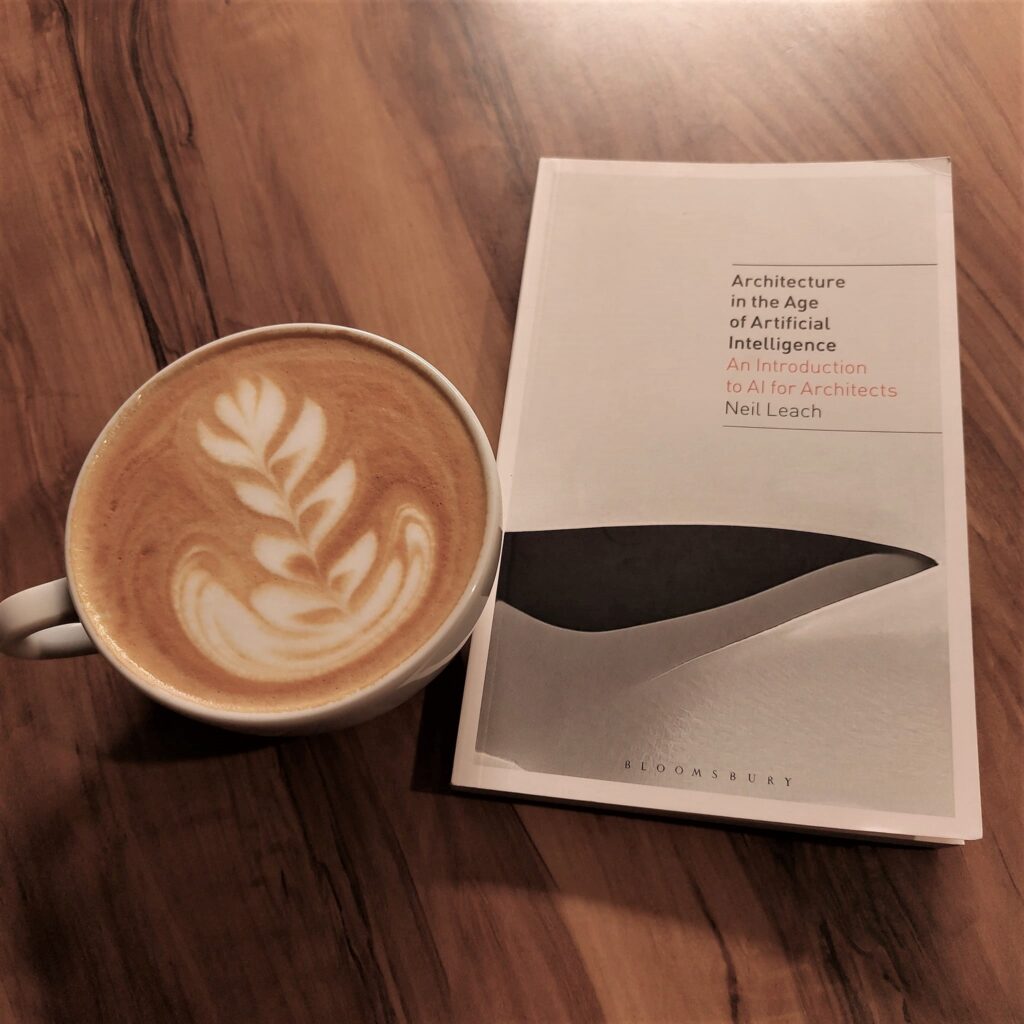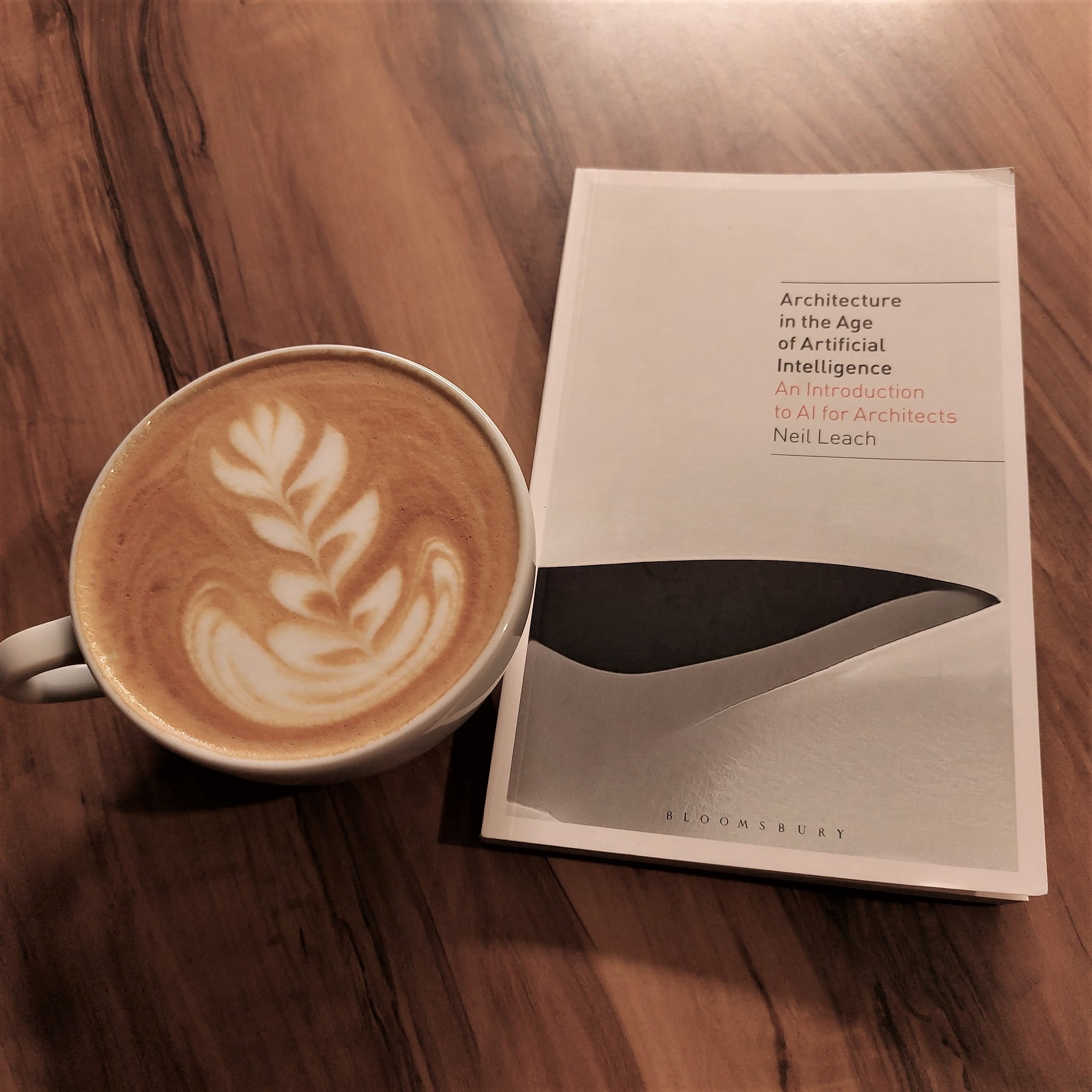For father’s day, I received this great book and want to share my review of this important work.

As Neil Leach writes, the development of this book has taken many years. If you are familiar with his career trajectory, you will agree that he always writes well-structured and well-researched books, as any critical scholar should. However, the topic of artificial intelligence in architecture (in both practice and discipline) is a relatively new phenomenon. It may even mark the peak of the digital revolution that began in the early 1990s. Writing a book about a technology undergoing accelerated innovation requires courage; in recent months, we have seen a proliferation of web-based AI applications that use GPT-3 and generative adversarial networks (GANs) that create marketing copy, blog content, and architectural illustrations through text prompt.
Leach begins by recounting the history of artificial intelligence within architecture and media art. He discusses several popular events that have drawn public attention to the technology, such as the Go match between Korean Lee Sedol and Deepmind’s artificial intelligence Alpha Go in 2016. The Ai eventually defeated Lee, the best Go player in the world, and he decided to quit his career. According to Leach, we may have to acknowledge the superior intelligence of Ai. In today’s world. Artificial intelligence is integral to a wide range of gadgets used daily. However, AI presents the paradox that as it becomes ubiquitous, it becomes invisible and operates in the background until it malfunctions, much like many large technological systems (LTS). According to Susan Leigh Starr, infrastructure systems are only visible when they fail.
On the controversial questions of authorship, Leach explores the ethics and potentials of neural networks sampling the creative history of humanity, or at least the one to which the neural network has access during its “training” session. In addition, the author speculates on AI’s potential beyond systematization and ponders its potential to enhance creativity in humans.
In the third and final section, the author examines possible scenarios for Ai in the production of architecture, the managing of smart cities, and the planet’s future. Here is where the book becomes projective and speculates on the approach architects, and designers can take when examining the potential future of AI in our built environment. It is significant to note that Leach does not present an answer to this question but rather lists a decalogue of possible outcomes. These include consequences for the architectural office, the architect’s education, and even the relationship between the architect and client. However, Leach emphasizes a final prediction we must all reckon with—the death of the architect.
Rene Peralta
Reseña del Libro, Architecture in the Age of Artificial Intelligence: An Introduction to AI for Architects. Autor Neil Leach
Para el día del padre, recibí este gran libro y quiero compartir mi reseña de esta importante obra.
Como afirma Neil Leach, la elaboración de este libro ha llevado muchos años. Si estás familiarizado con su trayectoria profesional, estarás de acuerdo en que siempre escribe libros bien estructurados y bien investigados, como debería hacer cualquier académico crítico. Sin embargo, el tema de la inteligencia artificial en la arquitectura (tanto en la práctica como en la disciplina) es un fenómeno relativamente nuevo. Puede que incluso marque el punto cumbre de la revolución digital que comenzó a principios de los años noventa. Escribir un libro sobre una tecnología que experimenta una innovación acelerada requiere valor; en los últimos meses, hemos presenciado una proliferación de aplicaciones de IA basadas en la web que utilizan GPT-3 y redes generativas adversariales (GAN) que crean textos de marketing, contenidos de blogs e ilustraciones arquitectónicas mediante la introducción de texto.
Leach inicia su libro relatando la historia de la inteligencia artificial en la arquitectura y el arte de los medios de comunicación. Analiza varios acontecimientos populares que han atraído la atención del público hacia la tecnología, como el partido de Go entre el coreano Lee Sedol y la inteligencia artificial Alpha Go de Deepmind en 2016. El Ai acabó derrotando a Lee, el mejor jugador del mundo, y este decidió dejar su carrera. Según Leach, quizá tengamos que reconocer que la inteligencia de la Ai es superior. En el mundo actual, la inteligencia artificial es parte integrante de una amplia gama de gadgets que se utilizan a diario. Sin embargo, la IA presenta la paradoja de que, a medida que se hace omnipresente, se vuelve invisible y opera en segundo plano hasta que funciona mal, como muchos grandes sistemas tecnológicos. Según Susan Leigh Starr, los sistemas de infraestructura sólo son visibles cuando fallan.
En cuanto a las opiniones sobre la autoría, Leach explora la ética y el potencial de las redes neuronales para muestrear la historia creativa de la humanidad, o al menos aquella a la que la red neuronal tiene acceso durante su sesión de “entrenamiento”. Además, el autor especula sobre el potencial de la IA más allá de la sistematización y reflexiona sobre su potencial para mejorar la creatividad en los seres humanos.
En la tercera y última sección, el autor examina los posibles escenarios de la IA en la producción de la arquitectura, la gestión de las ciudades inteligentes y el futuro del planeta. Aquí es donde el libro se vuelve propositivo y especula sobre el enfoque que pueden adoptar los arquitectos y diseñadores al examinar el futuro potencial de la IA en nuestro entorno construido. Es importante señalar que Leach no presenta una respuesta a esta pregunta, sino que ofrece un decálogo de posibles resultados. Entre ellas, las repercusiones para el despacho de arquitectura, la formación del arquitecto e incluso la relación entre el arquitecto y el cliente. Sin embargo, Leach hace hincapié en una predicción final con la que todos debemos contar: la muerte del arquitecto.
Rene Peralta

